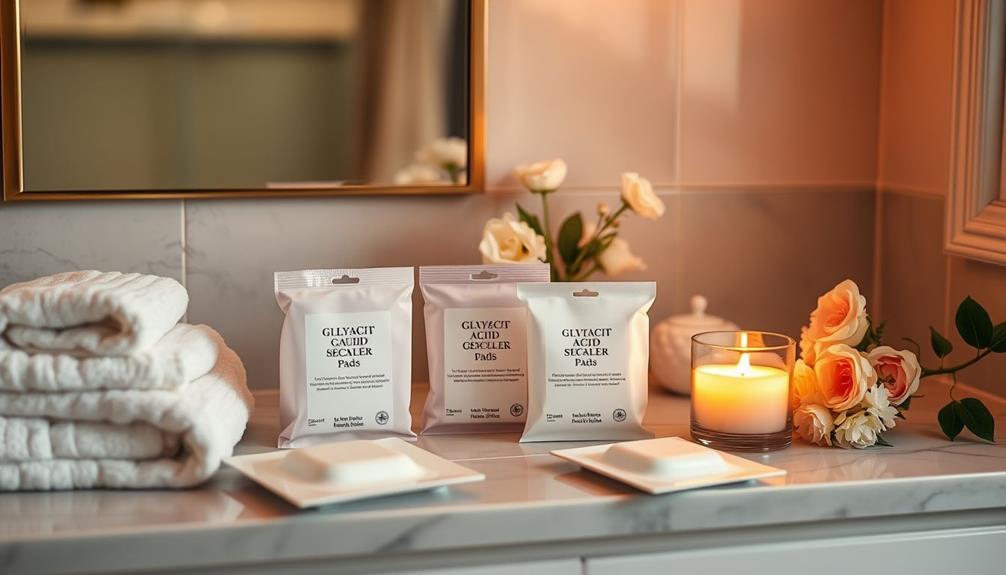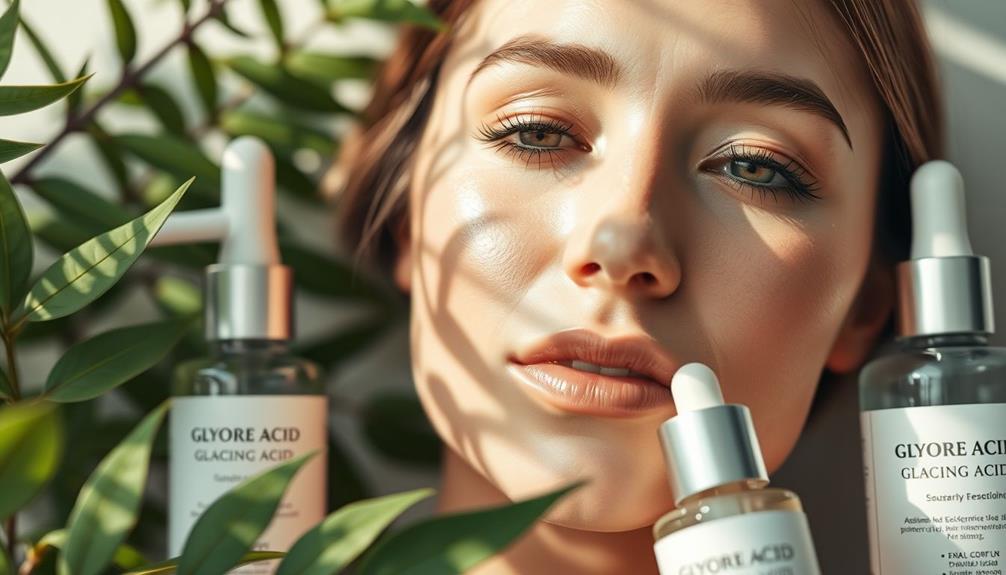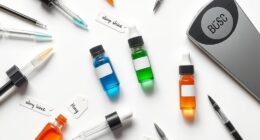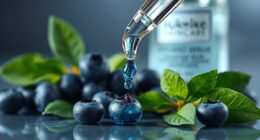Glycolic acid works wonders for your skin by gently exfoliating and promoting cell turnover. It breaks down the bonds holding dead skin cells together, revealing a smoother, brighter complexion underneath. This potent alpha hydroxy acid stimulates collagen production, reducing fine lines and enhancing overall skin texture. Suitable for most skin types, it can help treat acne and fade dark spots. Start with a lower concentration to gauge your skin's response and gradually increase use. Curious about the best products and tips to maximize your results? There's even more to uncover!
Key Takeaways
- Glycolic acid is a powerful exfoliant that enhances skin texture and promotes a brighter complexion.
- It stimulates collagen production, reducing fine lines and wrinkles for a smoother appearance.
- Regular use helps clear pores, preventing acne and minimizing hyperpigmentation.
- Suitable for various skin types, it's especially effective for normal, combination, and oily skin.
What Is Glycolic Acid?
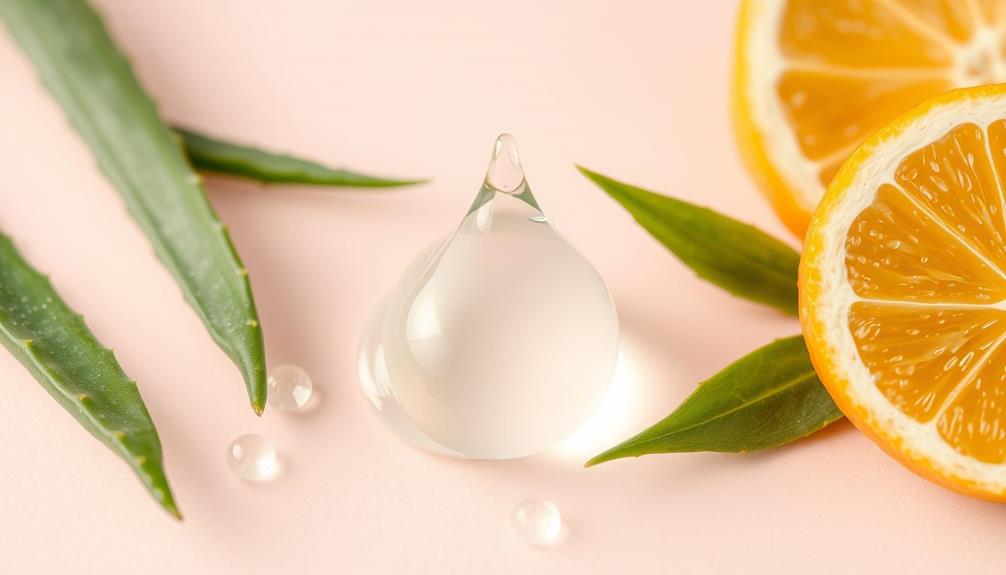
Glycolic acid, a potent exfoliant derived from sugar cane, is an alpha hydroxy acid (AHA) that helps reveal smoother skin by promoting cell turnover.
With its small molecular size, glycolic acid penetrates deeply, making it effective at dissolving the bonds that hold dead skin cells together. This process enhances your skin's texture, leaving you with a brighter complexion.
Additionally, incorporating essential oils for relaxation into your routine can further improve your skin's appearance by reducing stress, which often contributes to skin issues.
Glycolic acid's exfoliating properties cater to a wide range of skin types and concerns. Whether you're dealing with dullness, uneven texture, or fine lines, incorporating this AHA into your skincare routine can make a noticeable difference.
Typically available in concentrations from 5% to 20%, you can choose a strength that suits your needs, allowing for mild or more intensive exfoliation.
How Glycolic Acid Works
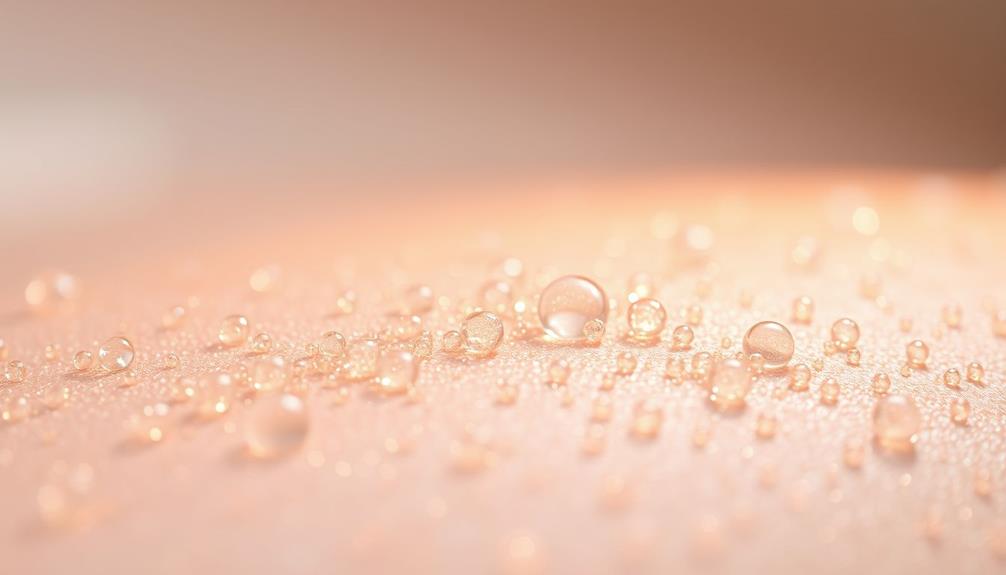
By breaking down the bonds between dead skin cells, glycolic acid effectively facilitates their removal and promotes a smoother skin texture. This powerful ingredient, a water-soluble alpha-hydroxy acid (AHA), penetrates deeply into the skin layers due to its small molecular size.
As you incorporate glycolic acid into your skin-care routine, you'll notice its exfoliating properties working wonders on your complexion. Additionally, maintaining a healthy skin routine is essential for overall skin health, much like how regular vet check-ups are vital for maintaining a cat's healthy weight throughout life cat health and nutrition.
Here are some key effects glycolic acid can have on your skin:
- Enhances collagen production: Stimulating fibroblast activity, it helps reduce the appearance of fine lines and wrinkles.
- Improves skin tone: Regular use promotes cell turnover, aiding in the fading of dark spots and hyperpigmentation.
With its ability to effectively remove dead skin cells and promote a more even skin tone, glycolic acid is an essential ingredient for anyone looking to achieve smoother, healthier skin. Embracing its benefits can lead to a radiant complexion that feels as good as it looks.
Benefits for Skin Health
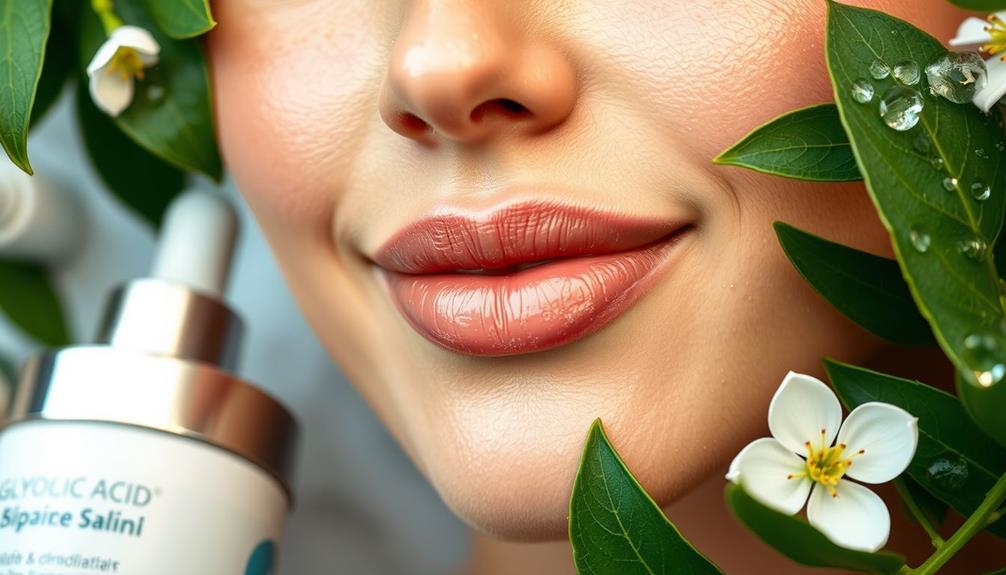
When you use glycolic acid, you're not just exfoliating; you're boosting your skin's cell turnover for a fresher appearance.
This powerful ingredient also helps treat and prevent acne by keeping your pores clear.
Additionally, incorporating regular treatments can enhance your skin's overall texture and tone, much like how deep conditioning treatments restore moisture to damaged hair.
As a result, you can enjoy a smoother, healthier complexion.
Exfoliation and Cell Turnover
Exfoliation with glycolic acid boosts cell turnover, revealing a smoother and more radiant complexion. This powerful alpha hydroxy acid (AHA) works by breaking down the bonds between dead skin cells, encouraging their shedding. As a result, you'll notice improved skin texture and clarity, making way for fresh, new cells.
Incorporating aromatherapy techniques alongside glycolic acid treatments can enhance your skincare routine by promoting relaxation and well-being.
Regular use of glycolic acid not only enhances your skin's overall health but also offers specific benefits, such as:
- Minimizing fine lines: Glycolic acid stimulates collagen production, helping to firm up your skin and reduce the appearance of fine lines and wrinkles.
- Fading uneven texture: With consistent exfoliation, you can achieve a more even skin tone and diminish dark spots, leading to a glowing complexion.
Acne Treatment and Prevention
Treating and preventing acne becomes easier with glycolic acid, as it effectively cleanses pores and reduces debris buildup. This powerful chemical exfoliant works by breaking down dead skin cells, promoting cell turnover, and helping you achieve clearer skin. If you have oily skin or are prone to breakouts, glycolic acid is a non-comedogenic option that won't clog your pores.
Here's a quick overview of how glycolic acid benefits your skin:
| Benefit | Description |
|---|---|
| Cleanses Pores | Breaks down debris and dead skin cells |
| Reduces Breakouts | Promotes quicker shedding of surface skin |
| Diminishes Scars | Helps fade existing acne scars and hyperpigmentation |
| Suitable for Oily Skin | Non-comedogenic formula that won't exacerbate breakouts |
| Visible Improvements | Higher concentrations offer notable results over time |
Incorporating glycolic acid into your skincare routine can considerably enhance your acne treatment efforts, leading to healthier and smoother skin. Regular use will leave your complexion looking vibrant and even-toned.
Suitable Skin Types
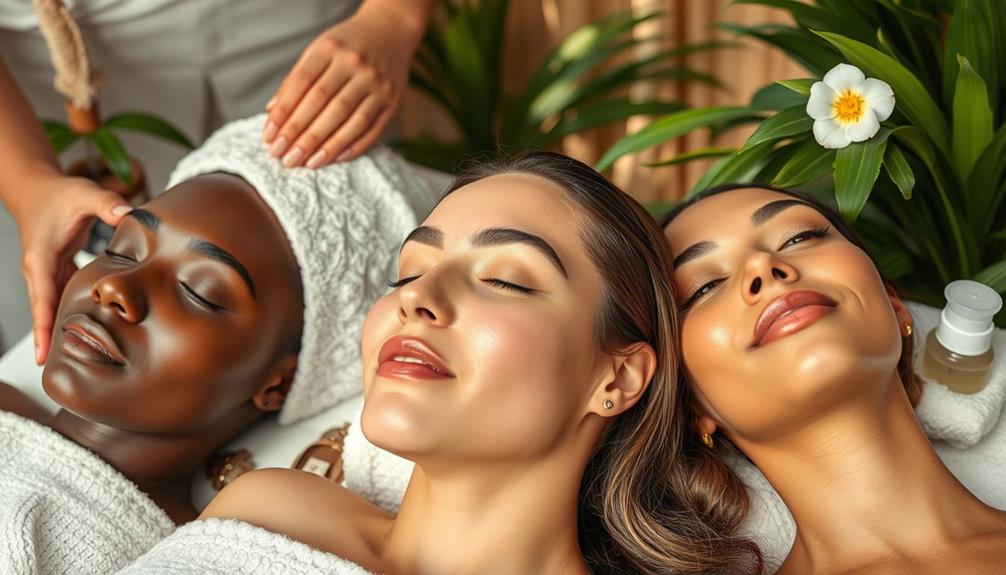
When considering glycolic acid, you'll find it works wonders for normal, combination, and oily skin types.
However, if you have dry or sensitive skin, you'll need to approach it with caution and start with lower concentrations.
It's crucial to understand your skin's needs to avoid irritation and get the best results.
Ideal Skin Types
Glycolic acid shines for those with normal, combination, and oily skin types, thanks to its powerful exfoliating abilities that help clear pores and reduce excess oil.
If you're struggling with acne-prone skin, glycolic acid can be particularly beneficial, as it unclogs pores and minimizes breakouts. However, if you have sensitive skin, you might want to proceed with caution. The acid's potent nature can cause irritation, especially if used in high concentrations or during harsh weather.
Here are some key points to take into account regarding suitable skin types for glycolic acid:
- Normal skin: Enjoys a smoother texture and improved radiance with regular use.
- Combination skin: Balances oil production and exfoliates dry areas effectively.
It's important to start with lower concentrations to gauge your skin's reaction.
Always apply sunscreen daily, as glycolic acid increases sun sensitivity, making your skin more vulnerable to damage.
Sensitive Skin Considerations
Sensitive skin requires special attention when incorporating glycolic acid, as its strong exfoliating properties can lead to irritation if not used carefully.
If you have sensitive skin, start with lower concentrations of glycolic acid (around 5-10%) to gauge your skin tolerance. This approach helps prevent adverse reactions and allows your skin to adapt gradually.
Before applying any glycolic acid products, it's vital to conduct a patch test. This simple step can help you identify any potential reactions before committing to full application. Observe how your skin responds over 24 hours to verify it doesn't react negatively.
You should also consider environmental factors, such as seasonal changes. For instance, during winter, your skin may become more sensitive, so adjusting your glycolic acid usage during this time is important.
If you find that your skin still reacts poorly, consulting a dermatologist can provide tailored advice and guarantee safe use.
Usage Guidelines
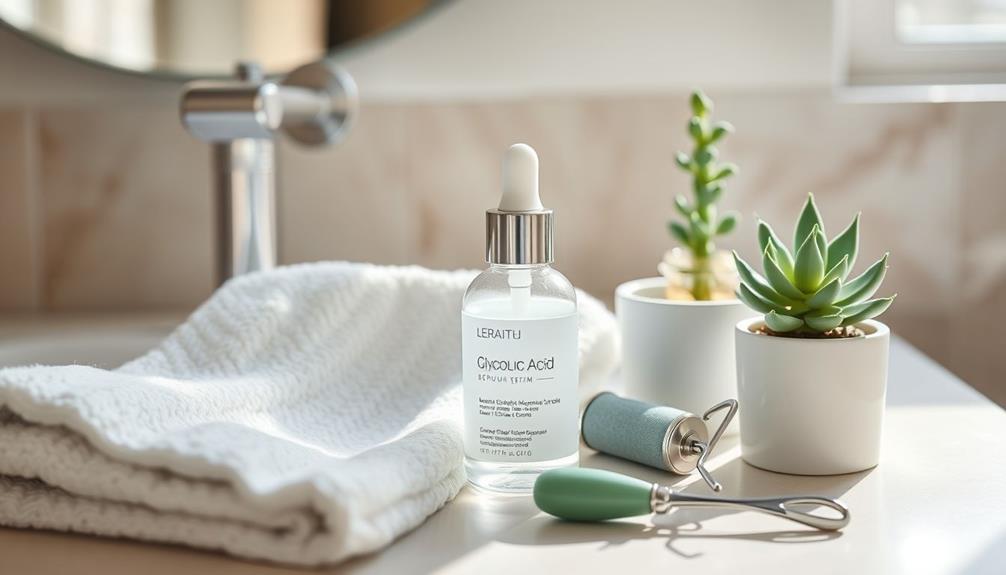
Start with a low concentration of glycolic acid, ideally 10% or less, to gauge how your skin responds. This is essential, especially for sensitive skin types.
Begin by incorporating it into your skin-care routine twice a week, and then gradually increase usage frequency based on how well your skin tolerates it.
Before diving in, always perform a patch test to identify any potential irritation. This small step can save you from unexpected reactions.
Remember to apply glycolic acid products at night; this minimizes sun sensitivity and allows your skin to reap the full benefits as it repairs overnight.
Here are some key guidelines to keep in mind:
- Use a daily sunscreen application to protect your skin, as glycolic acid can increase sun sensitivity.
- Assess skin tolerance regularly, adjusting your routine as needed based on your skin's response.
Application Methods
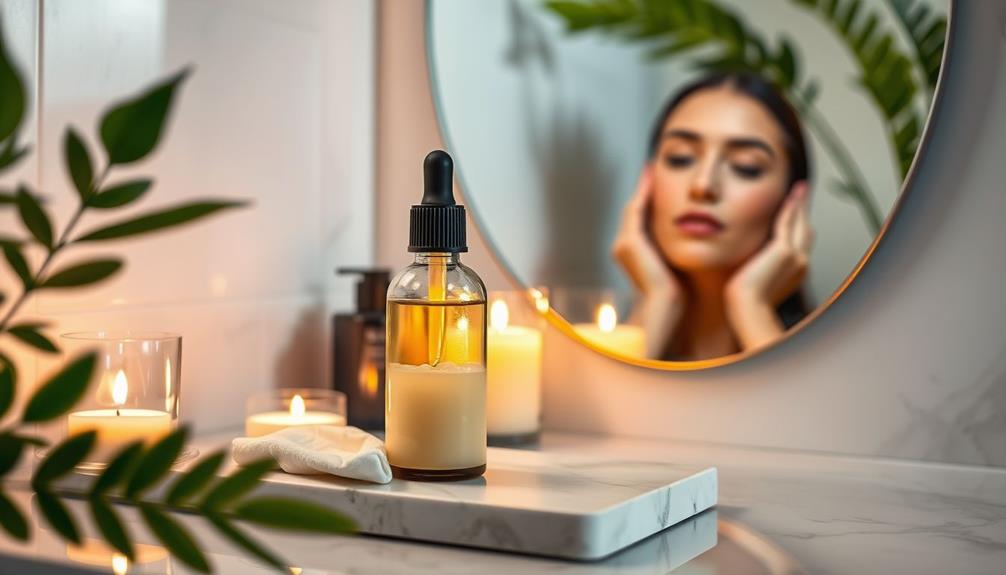
When incorporating glycolic acid into your routine, you can choose from various application methods that suit your skin's needs and preferences.
Glycolic acid cleansers and toners are great for daily use, gently exfoliating while removing impurities.
If you're looking for targeted treatment, consider glycolic acid serums that effectively address specific concerns like acne and hyperpigmentation, enhancing skin clarity and texture.
Moisturizers infused with glycolic acid not only hydrate your skin but also help smooth out fine lines, contributing to an overall improved skin appearance.
For a more intense experience, at-home peels, such as the GlyPro AHA Resurfacing Peel, offer deeper exfoliation with a higher concentration of glycolic acid. These products provide a spa-like treatment in the comfort of your home.
Before diving into any new glycolic acid product, it's crucial to perform patch testing. This step helps you assess your skin's tolerance and avoid any potential irritation.
Common Side Effects
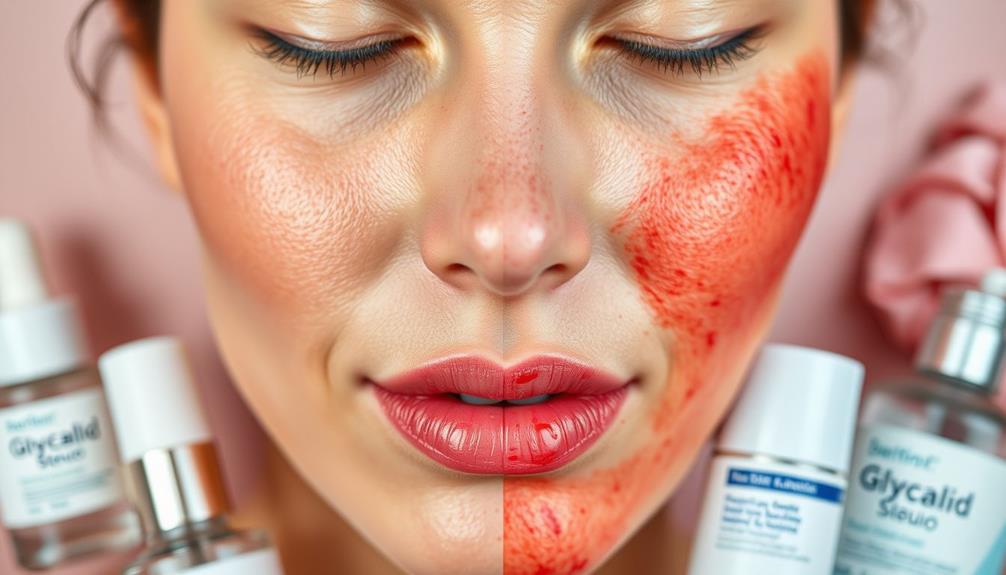
While glycolic acid can significantly enhance your skin's texture, it's important to be aware of its common side effects. Many users experience some degree of temporary redness, irritation, and mild peeling, especially when they first start using it or apply higher concentrations. If you have sensitive skin, you might find these effects more pronounced, so it's best to begin with lower concentrations and gradually increase your usage.
Here are a few common side effects to keep in mind:
- Temporary redness and irritation
- Mild peeling, particularly during initial use
Overuse of glycolic acid can compromise your skin barrier function, leading to heightened sensitivity and dryness. Additionally, avoid applying glycolic acid on broken or sunburned skin, as this can worsen irritation and discomfort.
Recommended Products
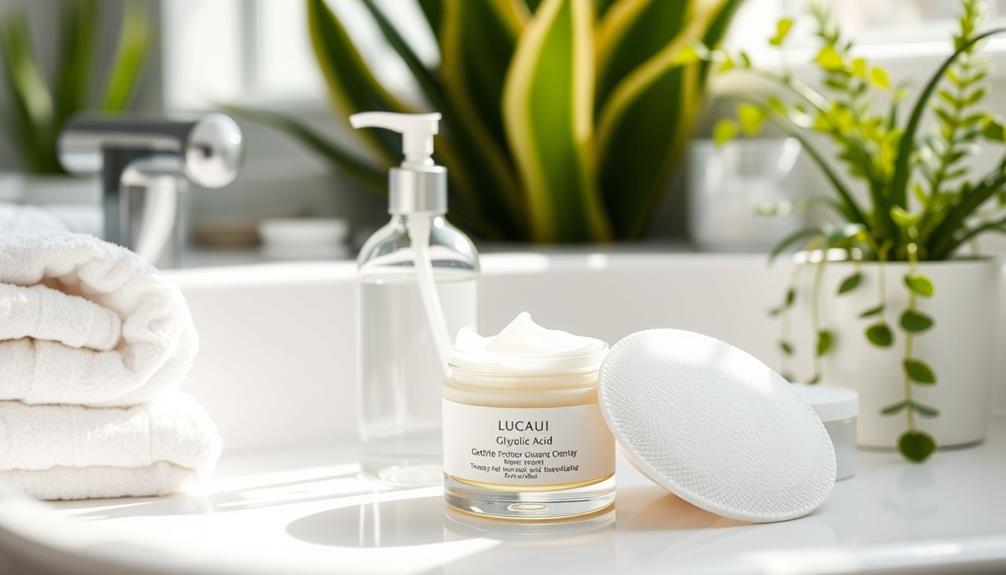
Discovering the right glycolic acid products can greatly elevate your skincare routine, helping you achieve that coveted smoother and brighter complexion.
One standout option is the GlyPro AHA Resurfacing Cleanser, which contains 10% glycolic acid and soothing ingredients like aloe vera, perfect for gentle exfoliation without irritation.
If you're looking for a powerhouse treatment, consider Drunk Elephant T.L.C Framboos Glycolic Night Serum. This glycolic acid product combines glycolic, salicylic, and lactic acids to deeply target pores and improve overall skin radiance.
For a budget-friendly choice, The Ordinary Glycolic Acid 7% Toning Solution provides mild exfoliation to brighten the skin and enhance texture over time.
To combat signs of aging while brightening your complexion, check out Murad Environmental Shield Vitamin C Glycolic Brightening Serum, which pairs glycolic acid with vitamin C for dual-action benefits.
Finally, treat yourself weekly with the Biossance Squalane + Glycolic Mask. This mask delivers enhanced exfoliation to remove dead skin cells and deeply hydrate, revealing a smoother, more radiant appearance.
Incorporate these products into your routine, and watch your skin transform!
Expert Tips for Use
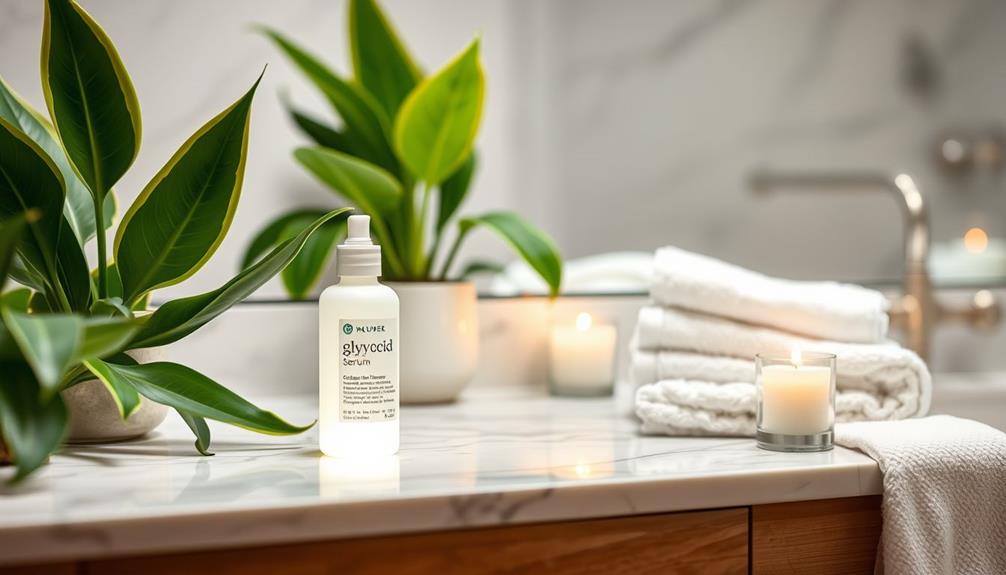
To get the most out of glycolic acid, start with lower concentrations and gradually increase as your skin builds tolerance. This helps to minimize irritation while allowing your skin to effectively shed dead cells. Here are some expert tips to keep in mind:
- Patch test any new glycolic acid products on a small area of skin before full application. This guarantees you won't experience any adverse reactions.
- Always apply glycolic acid products at night to reduce sun sensitivity. This timing allows your skin to repair while you sleep.
Additionally, don't forget the importance of sunscreen. Since glycolic acid can increase your skin's sensitivity to UV rays, applying a broad-spectrum sunscreen during the day is essential.
Conclusion
Incorporating glycolic acid into your skincare routine can be like planting seeds in a garden—nurturing your skin to bloom with radiance.
This powerhouse ingredient gently exfoliates, revealing smoother, healthier skin beneath the surface.
Remember to choose the right products for your skin type and follow usage guidelines to reap the full benefits.
With consistent care, you'll watch your complexion transform, making every day a step closer to that luminous glow you've been dreaming of!

